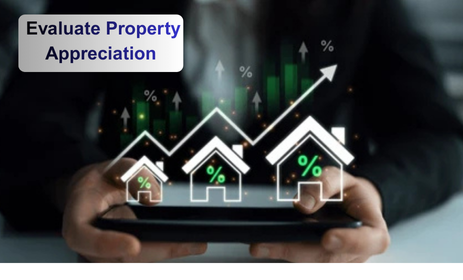How to Evaluate Property Appreciation
Read latest blogs and articles from Housystan

The Information mentioned here was last updated on:
25/11/2025Imagine buying a home today and discovering a few years later that its value has quietly climbed. That increase known as property appreciation is what makes real estate such a powerful tool for building wealth. But appreciation isn’t random. It follows patterns, trends, and local changes that you can observe if you know what to look for.
Understanding how to evaluate property appreciation doesn’t require an advanced degree or deep industry knowledge. It simply means paying attention to the right signals and interpreting them in a practical way. Whether you're shopping for your first home, thinking about an investment property, or trying to understand your local market, here are the key things that help reveal whether a property is likely to grow in value over time.
- Verified Tenants/Buyers
- Unlimited Property Listing
- Zero subscription/charges fee
Every neighborhood has a story, and one of the clearest ways to read it is through past property prices. Think of historical price trends as the heartbeat of the area.
If home values have risen steadily over the last decade not too fast, not too erratic it usually means the neighborhood has stable demand and a healthy environment for long-term growth. If the price chart looks like a roller coaster, appreciation may be unpredictable.
Look at:
These clues help you see whether the area typically grows, slows, or stays steady.
You’ve probably heard a hundred times that location matters. What’s more important is understanding why certain locations appreciate faster than others.
A property tends to grow in value when it makes life easier, safer, or more comfortable for the people living there. That’s why homes near schools, hospitals, shopping centers, and workplaces often see consistent appreciation. When an area checks the boxes for daily convenience, people want to live there and when demand rises, so do prices.
Access is another major factor. Properties close to metro stations, airports, highways, or even upcoming transportation plans often appreciate well because they improve mobility. Even the promise of a future road or rail line can create excitement and push values upward.
Safety also plays a big role. Families gravitate toward well-lit, low-crime communities, and higher demand naturally pushes prices up. A neighborhood’s reputation even word of mouth can influence appreciation more than many people realize.
Property values rise when more people want homes than there are homes available. This basic rule can tell you a lot about future appreciation.
If the neighborhood has limited listings but high interest, that’s a sign of rising value. Similarly, areas with heavy rental demand—like student zones, business hubs, or tourist spots—tend to grow faster because housing pressure increases.
But overbuilding can slow appreciation. If too many developers rush into a booming area, supply rises faster than demand, and prices may stall. Keeping an eye on local construction activity helps you understand which direction the market may be heading.
People’s preferences shape real estate trends. For example, the rise of remote work made larger homes with office space more valuable. Younger buyers often look for walkable areas with cafés and parks. Retirees may prefer peaceful, low-traffic neighborhoods.
Understanding who is moving into an area and why helps reveal whether demand is likely to grow or fade. When an area aligns with what people currently want, appreciation tends to be stronger.
Lifestyle shifts have become major drivers of real estate appreciation. For example, remote work increased demand for larger homes with office space. Similarly, young professionals prefer walkable neighborhoods with cafes and fitness centers.
If an area aligns with emerging lifestyle trends, it may experience above-average appreciation in the years ahead.
Evaluating property appreciation is not about guessing—it’s about reading the signals. By studying local trends, understanding economic drivers, and analyzing past growth, anyone can make informed real estate decisions.